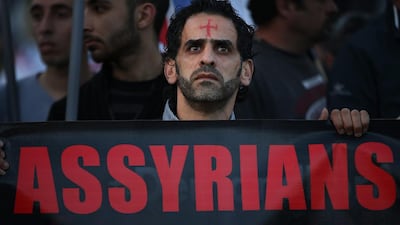The Assyrians who have now been targeted by ISIL for kidnapping in northern Syria have suffered like this before. But they also, further back in time, have a glorious history that illuminates one of the finest eras of Arab Muslim civilisation. If you have ever wondered how Christianity reached China, or how come the Mongols have an alphabet that is closer to Arabic than it is to the Chinese, the Assyrians are the answer.
They are descendants of the ancient Church of the East, which originally was the community of Christians who lived under Persian rule. This church is hardly known today, but it was once one of the world’s most important Christian churches: it sent the first missionaries to China in AD632, appointed bishops in Tibet and Kashgar, and established a flourishing intellectual community that translated Greek scholarship into Aramaic.
This was the lingua franca of the Middle East before Arabic, and remarkably it is still spoken by Assyrians today, which is one of the reasons that their targeting by ISIL is so significant and so tragic. It is yet another attempt by the extremist group to eradicate anyone or anything that is pre-Islamic.
The Assyrians’ translation of Greek scholarship later made it easier for Greek science and philosophy books to be translated into Arabic and stimulate the great intellectual renaissance of Islamic Baghdad.
Under the rule of the Abbasid caliphs in the 8th and 9th centuries, the Church of the East was not allowed to convert Muslims. However, it could convert non-Muslims, especially those living further east outside Islamic rule. So, under Muslim rulers, Christian patriarchs in Baghdad came to have sway over monasteries as far east as Beijing. They spread the Syriac alphabet, in which they wrote Aramaic, to the Uighurs and the Mongols (the Mongols still use it today) and were allowed to debate with the caliph himself on points of religion.
This was a time of great religious freedom. Free-thinkers, pagans and atheists were allowed to write books and teach. One man, Thabit ibn Qurra, wrote a paean of praise to “paganism”. Instead of being executed, burnt alive or whipped in public, he was invited to contribute his knowledge of mathematics to the burgeoning scholarly community in Baghdad. How different those caliphs were to the self-styled caliph who leads ISIL today. And how different are the results: the Arab rulers established an empire which was the envy of the world, while ISIL has created only a hellish nightmare in a decreasing segment of territory.
The Assyrians’s great culture was extinguished, along with much else, by the twin invasions of Genghis Khan and Tamerlane in the Middle Ages. Tamerlane ordered that nothing should be left standing in Baghdad that was not a hospital or a mosque. From then on, the adherents of the Church of the East lived in the highlands of northern Iraq, north-east Syria and south-east Turkey, which then were all part of the Ottoman Empire. Their patriarchs became hereditary rulers under Ottoman tutelage.
The Church of the East, meantime, split into factions some of which affiliated with the Roman Catholic Church and are now called Chaldeans. The Assyrians still have their own distinctive religious practices and beliefs. Traditionally, of all Christians they were the most uncomfortable with the belief that Jesus perfectly fused the natures of man and God. Perhaps for this reason or because of their long coexistence with Islam, they tend to avoid iconography in their churches.
As the Ottoman Empire died, it lashed out at the Christian communities that lived in what is now Turkey. It feared that they would side with Russia, and in 1915 and 1916 massacred them or sent them on forced marches to new homes in Iraq and Iran. Among those communities, most of whom were Armenian, there were many Assyrians.
After the First World War, these displaced Assyrians lobbied for an independent state with Mosul as its capital, which they would have shared with the Chaldeans and the Yazidis. But that never came to pass. Instead, that demand and their willingness to give military help to the British exposed them to further bouts of violence. These drove them onwards to Syria as twice-displaced refugees.
They have been refugees over and over. In Iraq last summer, Assyrians were again driven from their homes when ISIL seized Mosul and the towns to its east. Now they are also under siege in Syria. If they end up leaving the Middle East, as so many of Iraq’s Christians have already done, then it will be a tragic end to a glorious history.
Gerard Russell is author of Heirs to Forgotten Kingdoms: journeys among the disappearing religions of the Middle East
On Twitter: @gsjrussell

